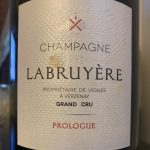 Yes, New Year’s day is more than a week behind us, and in any event, the dawn of 2021 wasn’t a terribly celebratory event. But I have a bottle of something very special in front of me, and I have to announce it as my wine of the week, month, and year, all: Champagne J.M Labruyère Prologue Extra Brut.
Yes, New Year’s day is more than a week behind us, and in any event, the dawn of 2021 wasn’t a terribly celebratory event. But I have a bottle of something very special in front of me, and I have to announce it as my wine of the week, month, and year, all: Champagne J.M Labruyère Prologue Extra Brut.
This is, without exception, one of the five finest Champagnes I’ve ever tasted. The winemaker Edouard Labruyère is heir to a fine wine empire, and this label is 100% Grand Cru and 100% from vines of Verzenay, a notable village in the Grande Montagne de Reims region. In fact, the fruit from these vines previously went into Dom Perignon wines. This is what’s known as a “grower” Champagne, meaning that the wine is not only made in the Champagne region, but also that the winemakers grow the grapes in their own vineyards. Grower Champagne houses, most that you’ve never heard of, produce dramatically fewer bottles than the so-called Grand Marques names you surely know—Bollinger, Heidsieck, Krug, Lanson, G H Mumm, Moët & Chandon, Pol Roger, Ruinart, Taittinger, Veuve Clicquot, and others.
This wine is 70% Pinot Noir and 30% Chardonnay. It was bottled in April 2014 and not disgorged for five more years, in May 2019. “Disgorgement” is one of the central processes of the Champagne method or Methode Champenoise, in which the dead yeast cells or lees are removed at the end of an aging process, leaving clear, pure wine. During those five years, the interaction of the wine and the lees produces amino acids, and lots of other stuff such as peptides, nucleotides, and mannoproteins, adding complexity, softness, and nutty, biscuity flavors, among others.
One of the reasons I love this wine so much is because it’s exceptionally dry, “Extra Brut,” even drier than Brut which is the style of the vast majority of Champagne, because it gets only a smidge of “dosage.” So a little info here. Dosage, sometimes called liqueur d’expédition, is the last step before final corking—a small quantity of the base wine and sugar is added to take the edge off of very dry wine. Most Brut Champagnes have less than 12 grams of sugar per litre, and Extra-Brut like this one, a meager 0-6 grams of sugar per litre. And this one has almost no sugar, 1.6 grams per liter. So if you’re used to Brut or even sweeter styles of Champagne, this one may really wake or even shock your palate.
But hey: This wine is marvelous. The high percentage of Pinot Noir gives it great structure, toast and hazelnut aromas, with notes of berry, grapefruit and spice and a long crisp finish. Enjoy.
